2023广东中考英语试卷真题及答案
2023广东中考英语试卷真题及答案是什么?中考英语想拿满分,需要做到两点,一是对单词量的积累,二是对语法知识的掌握。下面是小编整理的关于2023广东中考英语试卷真题及答案的内容,欢迎阅读借鉴!
2023广东中考英语试卷真题
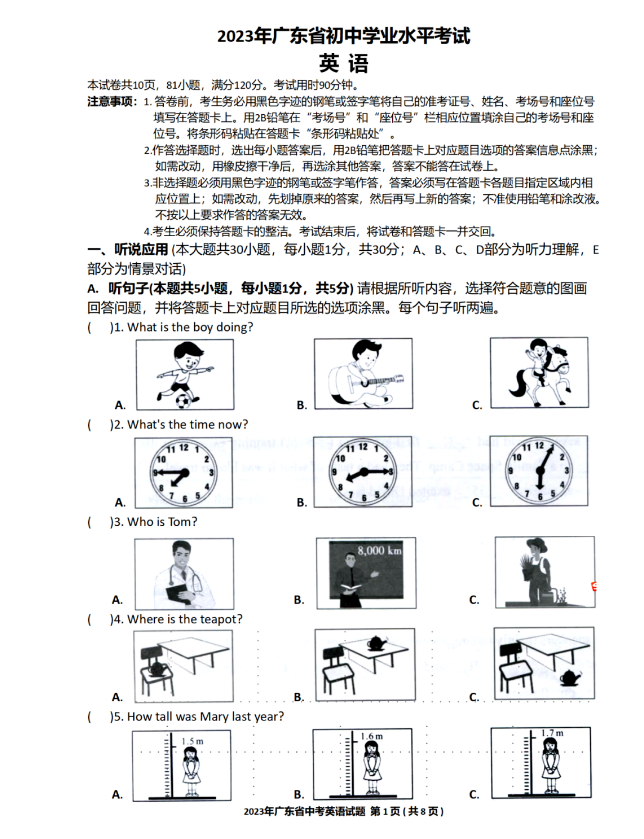
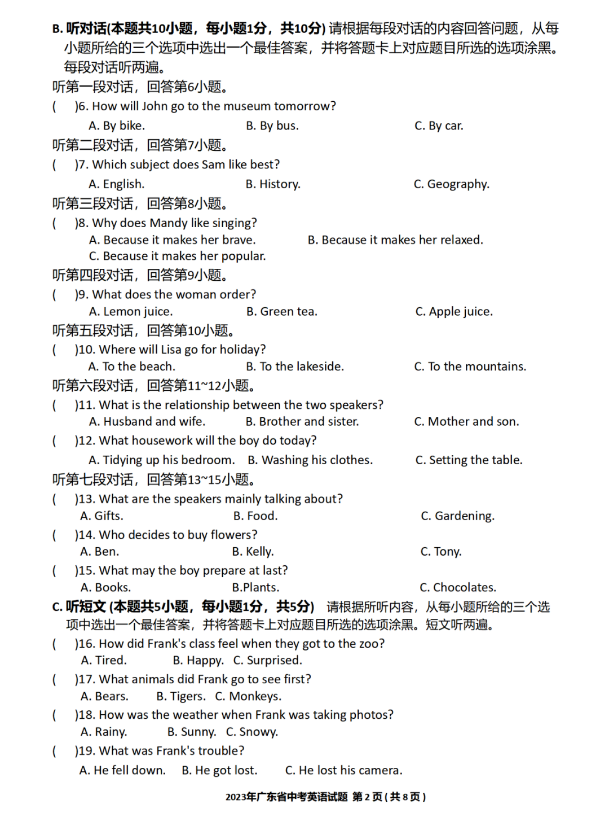
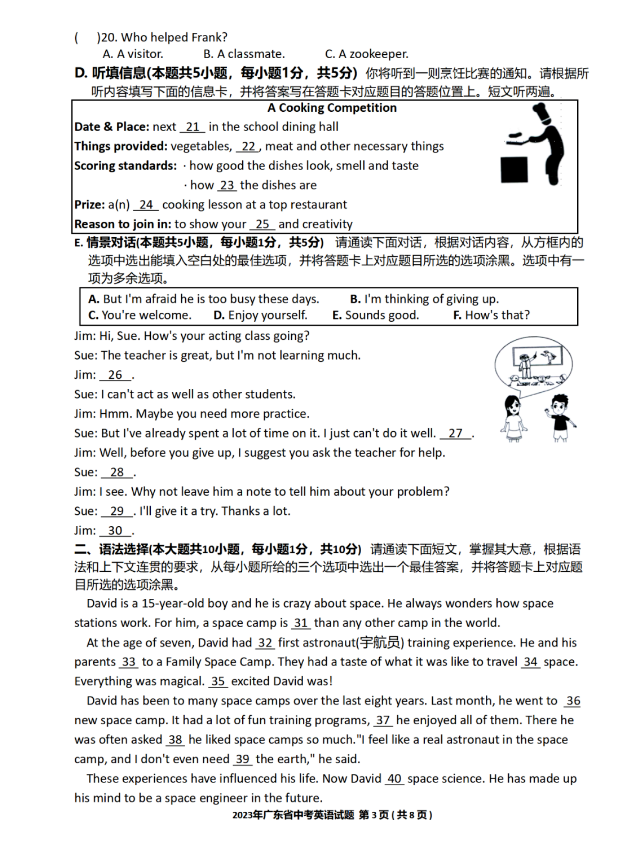
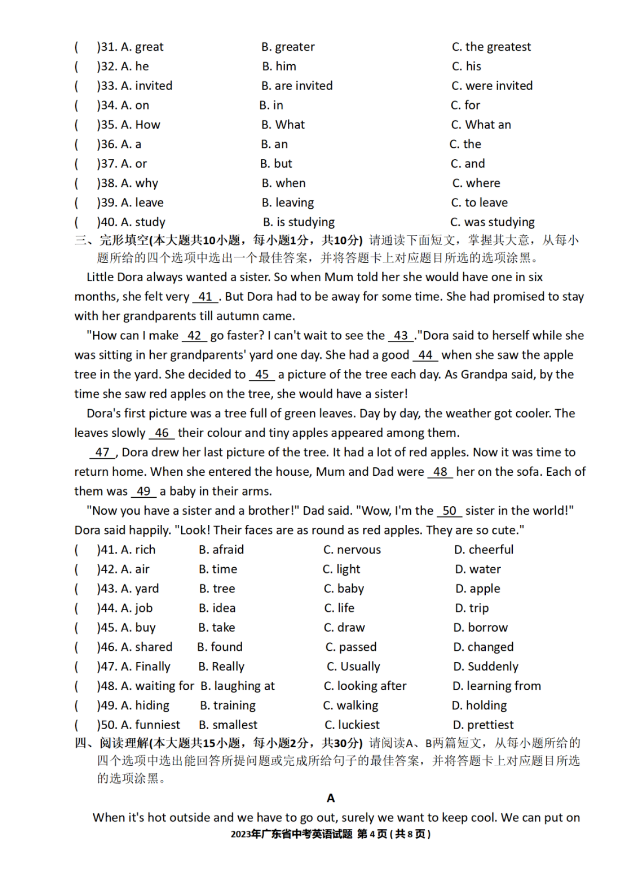
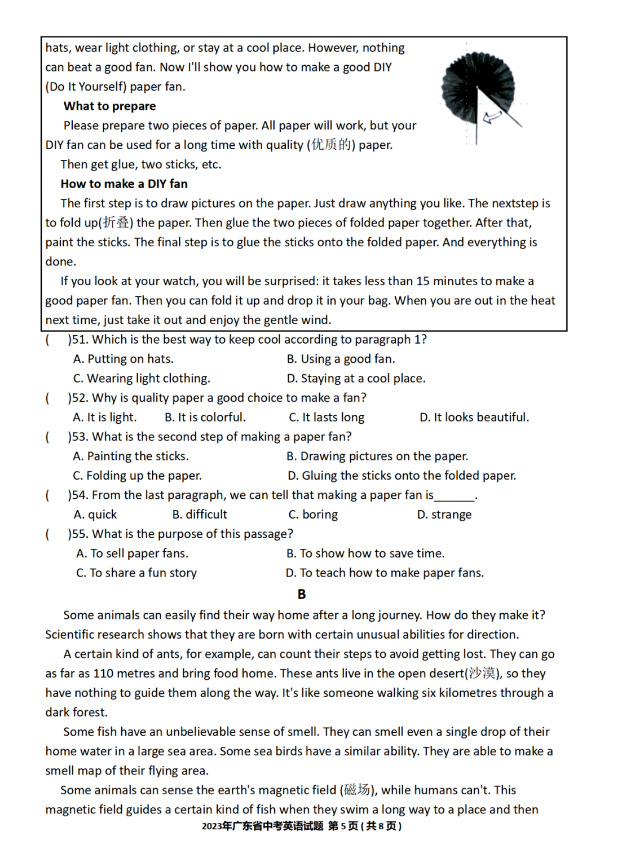
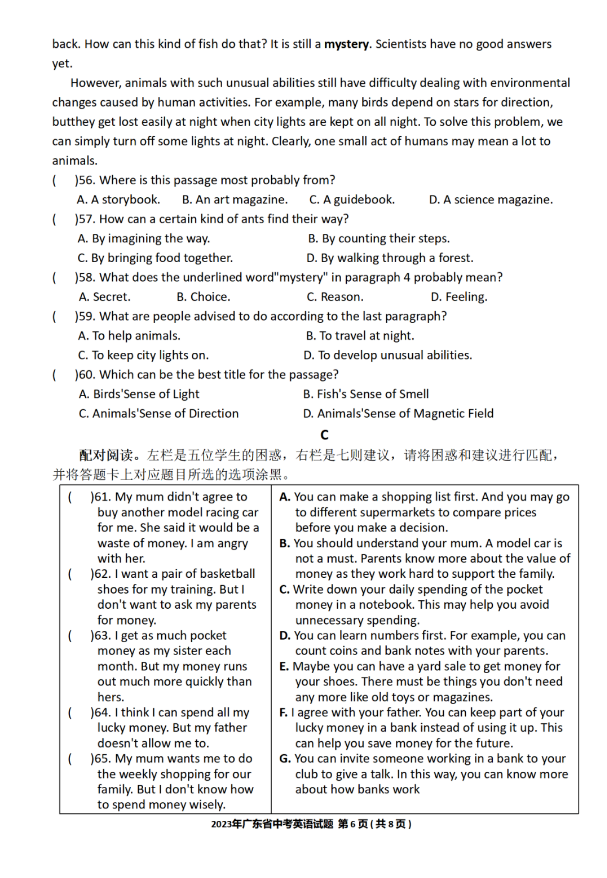
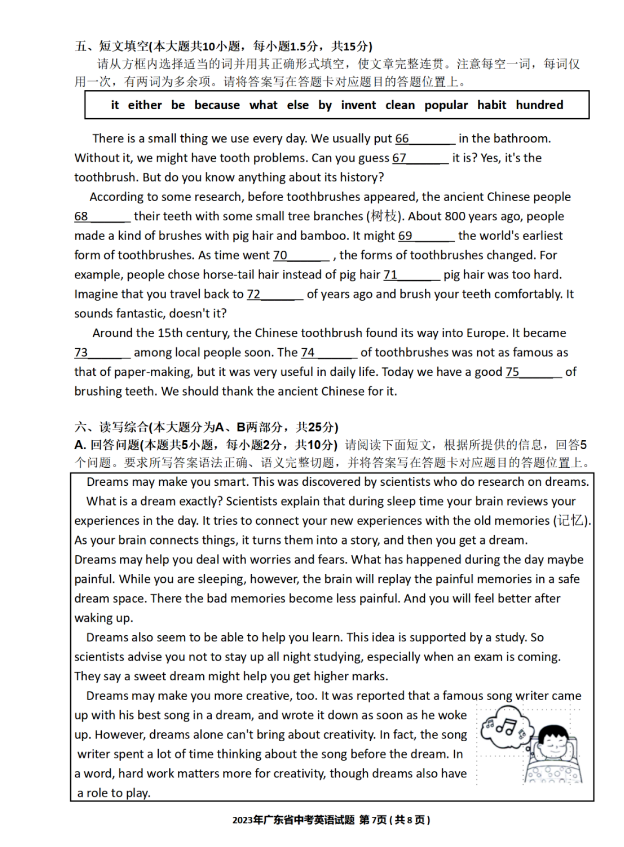
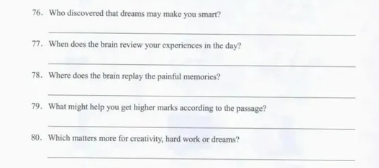
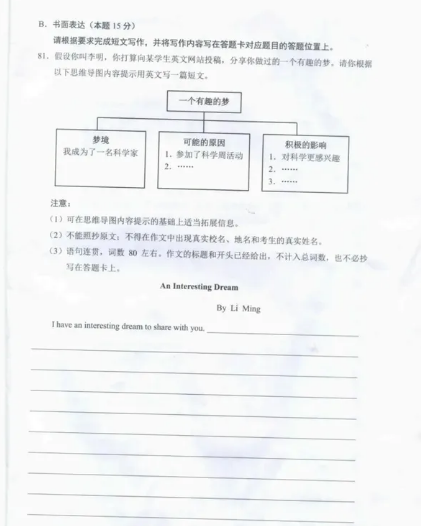
2023广东中考英语试题参考答案
一、1~5 BAACB 6~10 BCBAC
11~15 CAABA 16~20 BCABC
21. Monday 22. eggs 23. healthy
24. free 25. skills
26~30 FBAEC
二、31~35BCCBA36~40ACACB
三、41~45DBCBC 46~50DAADC
四、51~55BCCAD 56~60DBAAC
61~65BECFA
五、66. it 67. what 68. cleaned
69. be 70. by 71. because
72. hundreds73. popular
74. invention 75. habit
六、76. Scientists who do research
ondreams (discovered it).
77. During sleep time.
78. In a safe dream space.
79. A sweet dream.
80. Hard work.
81. 略
中考英语知识点:词法
1. 名词
(1)名词的可数与不可数
可数名词指表示的人或事物可以用数来计量,它有单数与复数两种形式。不可数名词指所表示的事物不能用数来计量。物质名词与抽象名词一般无法用数目,来统计,都成为不可数名词。
不可数名词前一般不能用冠词a、an来表示数量,没有复数形式。要表示“一个……”这一概念,就须加a piece of这一类短语。要注意许多名词在汉语里看来是可数名词,在英语里却不可数。如:chalk,paper,bread,rice,grass,news等。
(2)名词复数的规则变化
A.一般情况下加-s。
B.以s, x, ch, sh, 结尾的加-es
C.以辅音字母加y结尾的改y为i再加-es
D.以f,fe结尾的,去掉f或fe,变成v再加-es
(3)名词的所有格
A. 单数名词词尾加’s,复数名词词尾若没有s,也要加’s。
如:the worker's bike,the Children’ s ball
B. 表示几个人共有一样东西,只需在最后一个人的名字后加’ s若表示各自所有,则需在各个名字后’ s。
如: This is Lucy and Licy’ s room.
These are Kate's and jack’ s rooms.
C. 如果是通过在词尾加—s构成的复数形式的名词,只加’。
如:the students’ books,the girls’ blouses
(另外:名词+of+名词名词是有生命的,我们就用’s结构来表示所有关系。如果名词所表示的事物是无生命的,我们就要用名词+of+名词的结构来表示所有关系。)
2. 代词
人称代词,物主代词,反身代词,指示代词,不定代词
(1)人称代词
第一人称单数
I me my mine myself
复数 we us our ours ourselves
第二人称
单数 you you your yours yourself
复数 you you your yours yourselves
第三人称
单数 he him his his himself
she her her hers herself
it it its its itself
复数 they them their theirs themselves
(2)物主代词
物主代词的用法:形容词性物主代词后面一定要跟上一个名词;
名词性物主代词可作主语、表语、宾语。
(3)反身代词
反身代词的构成分两种:第一、二人称反身代词在形容词性物主代词后加上self或selves,第三人称的反身代词在宾格代词后加上self或selves.
反身代词的用法:一种是作宾语,由主语发出的动作又回到动作者本身。如:I enjoyed myself at the party. 另一种是作名词或代词的同位语;用来加强语气。如:I can do it myself.
(4)指示代词
指示代词的特殊用法:
(1)为了避免重复,可用that,those代替前面提到过的名词,但是this,these不可以。
(2)this,that有时可代替句子或句子中的一部分。
(5)不定代词
one,some,any,other,another,all,both,each,neither,many,much等
3. 冠词
(1)不定冠词an用在元音读音开头(不是指元音字母)的词前,其余用不定冠词a.
(2)定冠词的基本用法
A. 用在重新提到的人或事物前面。
B. 指谈话双方都知道的人或事物前面。
C. 用在单数可数名词前面,表示某一类人或事物。
(3)定冠词的特殊用法
A. 用在世界上独一无二的事物或方位名词前。
B. 用在序数词、形容词的最高级及only所修饰的名词前。
C. 用在江河、海洋、山脉、湖泊、群岛的名称前面。
D. 用在由普通名词和另外一些词所构成的专有名词前面。
E. 用在姓氏的复数形式前面,表示全家人或这一姓的夫妇二人。
F. 用在乐器名称前。
G. 和某些形容词连用,表示某一类人或事物。
(4)名词前不用冠词的情况
A. 在专有名词 (包括人名、地名、节日、月份、季节) 、物质名词和抽象名词前—般不用冠词。但在以Festival组成的民间节日前要加the。
B. 表示一类人或事物的复数名词前。
C. 名词前有物主代词、指示代词、不定代词或名词所有格修饰时,不用冠词。
D. 三餐饭、球类、棋类、游戏名称前一般不用冠词。正在有些词组中,有无冠词含义不同。
(sit) at table就餐; sit at the table坐在桌边
go to school去上学;go to the school去那所学校;in hospital住院;in the hospital在那个医院里
4. 数词
(1)数字的表示
三位数数词要在百位和十位(若无十位则和个位)之间加and。
1,000以上的数字,从后向前第三位数加一个“,”,第一个“,”前为thousand,第二个“,”前为million,第三个“,”前为billion。
(2)序数词除了first,second,third外,其余都在基数词尾加-th构成。
(3)分数分子在前,分母在后,分子用基数词,分母用序数词,当分子大于1小时,分母序数词要变成复数。
(4)hundreds(thousands,millions)of……
5. 形容词、副词
(1)形容词的位置
A. 形容词作定语一般要放在名词前面,但当形容词修饰不定代词something,nothing,anything时要放在所修饰的不定代词之后。如:something important,nothing serious。
B. 当形容词带有表示度量的词或词组作定语或表语时,定语或表语要后置。如:
We have dug a hole two meters deep.
The hole is about two metres deep.
(2)形容词的比较等级
单音节词和少数双音节词,在词尾加—(e)r,—(e)st来构成比较级和最高级。其他双音节词和多音节词,在前面加more,most来构成比较级和最高级。如:
popular———more popular———most popular
important—more important—most important
(3)副词的比较等级
单音节副词和个别双音节副词通过加-er,-est来构成比较级和最高级。绝大多数副词借助more,most来构成比较级和最高级。
(4)少数形容词和副词比较级/最高级的不规则变化:
原级 比较级 最高级
well —— better —— best
badly —— worse —— worst
much —— more —— most
little —— less —— least
far —— farther —— farthest
farthest furthest
late —— later —— latest
(5)副词的最高级前面可以不加定冠词the。
6. 介词
(1)表示时间的介词及介词短语
in, at, on, before,after,till,since,for, fromto, until, by,in the middle of,at the beginning of, at the end of,at half past five,at night,in a week,in the morning,in class,at sunrise, in spring/summer/autumn/winter,on Sunday,on Saturday afternoon,on a winter evening,for a long time,for two months,after school,since liberation,before lunch,at the time of,at the age of
(2)表示地点的介词及介词短语
in,at,into,to,on,beside,before,behind,above,under,outside,inside,up,from,far,from,near,across, off, down, among, past,between,out of,around,in the front of, in the middle of, at the back of,at the foot of,at home,at the gate,at the table,in the sky, on the ground,in a tree, in the south,in the sun,in the bed,on one’s way home,by the side of
中考英语知识点:对定语从句的考查
一.定语从句的功用和结构
在复合句中,修饰某一名词或代词的从句叫做定语从句。被定从句修饰的词叫做先行词。定语从句必须放在先行词之后。引导定语从句的关联词有关系代词和关系副词。例如:
This is the present that he gave me for my birthday
二.关系代词和关系副词的功用
关系代词和关系副词用来引导定于从句,在先行词和定语从句之间起纽带作用,使二者联系起来。关系代词和关系副词又在定语从句中充当一个成分。关系待客做主语,宾语,定语,关系副词可作状语。
1. 作主语:关系代词在定语从句中作主语时,从句的谓语动词的人称和数须和先行词一致。例如:
I don’t like people who talk much but do little.
The cars which are produced in Hubei Province sell very well.
2. 作宾语:She is the person that I met at the school gate yesterday.
The book that my grandmother gave me is called “The Great Escape”.
3. 作定语
关系代词whose在定语从句中作定语用。例如:
What’s the name of the young man whose sister is a doctor?
The girl whose father is a teacher studies very hard.
4. 作状语
I’ll never forget the day when I first came to Beijing.
三. 各个关系代词和关系副词的具体用法
1. who 指人,在定语从句中作主语。例如:
The person who broke the window must pay for it.
The boy who is wearing the black jacket is very clever.
2. whom指人,在定语从句中作宾语。例如:
Do you know the young man (whom) we met at the gate?
Mr Lee (whom) you want to see has come.
3. whose 指人,在定语从句中作定语。例如:
The girl whose mother is ill is staying at home today.
I know the boy whose father is a professor.
4. which指物,在定语从中作主语或宾语。例如:
A dictionary is a book which gives the meaning of words.
Here is the book (which) the teacher mentioned yesterday.
5. that多指物,有时也指人,在定语从句中作主语或宾语。例如:
I’ve read the newspaper that(which) carries the important news.
Who is the person that is reading the newspaper over there?
6. when 指时间,在定语从句中作状语。例如:
I’ll never forget the time when we worked on the farm.
He arrived in Beijing on the day when I left.
7. where 指地点,在定语从句中作状语。例如:
This is the house where we lived last year.
The factory where his father works is in the east of the city.
四. 关系代词 whom, which 在定语从句中作介词宾语时,可以和介词一起放于先行词与定语从句之间,有时为了关系紧凑也可以将 whom 与 which 与先行词紧挨着书写,而将介词置于定语从句的后面,如:
That was the room in which we had lived for ten years. = That was the room
which we had lived in for ten years.
五. 具体使用时还要注意下列问题:
1. 只能使用that,不用which 的情况:
(1) 先行词是all, few, little, nothing, everything, anything 等不定代词时。例如:
All that he said is true.
(2) 先行词被only, no, any, all,等词修饰时。例如:
He is the only foreigner that has been to that place.
(3) 先行词是序数词或被序数词修饰的词。例如:
He was the second (person) that told me the secret.
(4) 先行词是形容词最高级或被形容词最高级修饰的词。
This is the best book (that) I have read this year.
(5) 先行词既包括人又包括物时。例如:
He talked about the people and the things he remembered.
2. 只能用which,不用that 的情况:
(1) 在非限制性定语从中。例如:
The meeting was put off, which was exactly what we wanted.
(2) 定语从句由介词+关系代词引导,先行词是物时。例如:
The thing about which he is talking is of great importance.
考查的主要形式是单项填空、完型填空、短文填空和完成句子。阅读理解和书面表达肯定也要用到定语从句。
中考英语知识点:主动语态和被动语态
1.主动语态是表示主语是谓语动作的使动方的语态。在主动语态中,谓语的动作源自主语,而施加于宾语。
2.被动语态是动词的一种形式,用以说明主语与谓语动词之间的关系。
3.主动语态和被动语态的区别
在主动语态中,主语后面接人(be+动词原型);被动语态(be+动词过去分词)。
举例:
(1)主动语态:We use electricity to run machines.我们用电力来开动机器。
被动语态:Electricity is used to run machines. 电力被我们用来开动机器。
(2)主动语态:Bell invented the telephone in 1876.贝尔于1876年发明了电话。
被动语态:The telephone was invented by Bell in1876.电话是贝尔于1876年发明的。